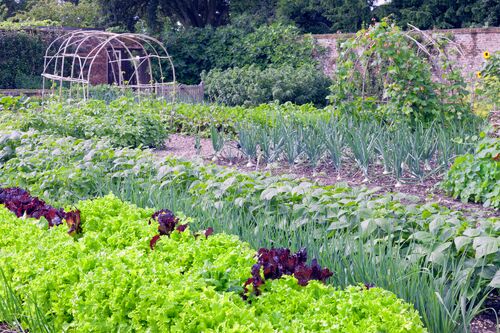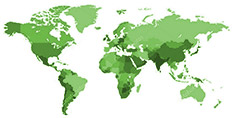Growing Herbs and Vegetable in a Large Garden

Do you have a large garden and want to grow your own vegetables and herbs in addition to perennials and flowers? Of course this is possible.
For example, you can create a separate vegetable garden in your backyard. Make beds and/or build raised beds or containers.
If you don't want a separate vegetable part, vegetables and herbs also fit perfectly between the other plants. In fact, many types of vegetables and herbs are decorative. For example, they have beautiful foliage and often bloom beautifully. And, not unimportant, herbs also attract many insects. What could be more fun than making part of your garden edible?
The location of the garden
A larger garden usually has sunny, semi-shaded and shaded areas. Although growing most types of vegetables and herbs requires a lot of sunlight, there are also varieties that do well in (semi-) shaded places. Pay attention to this when you make a garden plan and take in account which plants you place next to each other. After all, if these plants become large, they will create shade in a sunny spot.
The size of the garden
Of course, you have more options in a larger garden than in a small one. You could, for example, use a piece to create a vegetable garden. You could even separate this from the ornamental garden.
It is important to make a good layout. For example, by creating beds, with paths in between. Look carefully at the size of the beds. By making them not too wide, you can harvest without having to stand in them. For more information, see making a sowing plan.
It is also possible to make raised beds. This has a number of advantages, such as not having to bend over and pests can also reach it more difficult. In addition, it offers protection in case of heavy rain. However, you should make sure that the containers dry out quickly in hot weather.
Or grow vegetables and herbs between the other plants. Many species are decorative. Think, for example, of chard, which is available in different colours, palm kale, with a special shape, or different types of legumes, such as peas, along pyramids of bamboo sticks, creating height in the garden. There are many possibilities in a large garden. This means you can have a bigger and more varied harvest than, say, from a smaller garden.
If you have enough space, you could also consider a greenhouse. This increases the species you can grow. Think, for example, of special tomato varieties or tropical crops, such as the horned melon https://www.dutchgardenseeds.co.uk/vegetable-seeds-kiwano-or-horned-melon/
Pre-sowing of Seeds
To be able to harvest in the summer, it is wise to pre-sow some varieties indoors.
These are varieties that need a lot of heat and therefore take a longer time to grow in our climate. For example gherkin, pepper, eggplant, sweet pepper and tomatoes.
But other varieties can also be pre-sown, so that they can be harvested earlier in the season.
Whether this is necessary, how and when is often indicated in the description on the seed package. Pre-sow in small pots, for example these seed trays, after which you place them in a warm, light spot. For example, the windowsill. If you have a greenhouse, you could also put them in there, depending on the outside temperature.
You can use vermiculite and/or seed and cutting soil as a nutrient medium. vermiculite, together with the organic seed and cutting soil, is the ideal sowing soil for your seeds! The great thing about vermiculite is that it absorbs water easily and therefore also retains nutrients well. Due to the fine structure, you can easily grow and transplant your seedlings without damaging the roots.
You can also make your own potting soil mixture; mix 1 part of vermiculite with 3 parts potting soil. This keeps your sowing soil lighter and airier, and the vermiculite also keeps the nutrients and water accessible to your plants for longer.
Last but not least, we have special spongepot seed tray in our assortment, including bacto, which makes germinating seeds even easier! When the plants are big enough, they can be repotted into larger pots or planted out in the garden.
The soil
When growing vegetables and herbs in the open ground, the soil is of great importance. For example, do you have sandy, loamy or clay soil? And are there enough nutrients in it? To be sure whether the soil is suitable, you could have a soil test done. This is offered in many garden centres. You will often also receive tips on how this can be improved. You may need to improve it first in order to get a good harvest. For more information, see how-to-grow-vegetables, growing-herbs and Soil types and how to improve them.
Nutrition
Depending on the type of vegetable or herb, nutrition may need to be given during the growing season. This is often written on the package and also on our website. Under https://www.dutchgardenseeds.co.uk/how-to-grow-vegetables/ and https://www.dutchgardenseeds.co.uk/growing-herbs/ , you will find a lot of information and tips about the different varieties.
Nutrition can be added before sowing and/or transplanting, so that the plant is well supported from the start. This can be done, for example, with mycorrhizae. For more information, see also growing vegetables and herbs, general information.
The type of vegetables and herbs
In a large garden, you can grow all kinds of vegetables and herbs and there is a lot of choice. So how do you decide what you want to grow?
First of all, you could take into account whether something is easy or more difficult to grow. If you are a novice vegetable gardener, choose mainly easy-to-grow vegetables. Nothing is more demotivating than no or little harvest.
Furthermore, take into account the type of soil in your garden. Choose species that can grow on this soil, or try to improve the soil (see soil types and improving them).
Location is also an important factor. Is it a sunny, semi-shady or shady spot? There is a suitable vegetable species or herb for every pitch. And take into account the height and size of the crop and which varieties grow well side by side or not. This is also known as ‘good and bad neighbours’.
Also think about edible flowers! Colourful in both garden and on your plate.
But the most important factor, of course, is what you like. Or what you would like to try. Freshly harvested vegetables, fruits and herbs often taste much better than from the supermarket. So, it is really worth it to try growing your own veggies.
Did you become enthusiastic by all of this and do you want to grow your own vegetables, herbs and flowers? And do you need seeds?
Dutchgardenseeds.com has a wide range of high-quality seeds, with many organic varieties as well. Take a look at our website, with lots of information about growing your own vegetables, herbs and flowers.
Buying seeds in our webshop is definitely a good choice. We are always there for you. If you have any questions about, for example, your order, you can always contact us. The nice thing about growing vegetables from vegetable seeds is that the plants are often stronger and also grow without pesticides. So, it's a fun activity and a healthy one at the same time!



